
The experiments at SITE Global’s welcome reception were intended to give guests a wide range of choices about how they spent their time — dancing, talking, experiencing the host city, or none of the above. (All photos by Vision Photo)
Celebrating its 50th anniversary next year, the Society for Incentive Travel Excellence (SITE) has been holding meetings — including its annual SITE Global Conference — for a long time, points out Tahira Endean, CMP, DES, CED.
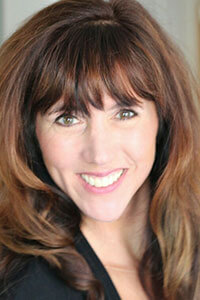
Tahira Endean
“Nothing was broken,” Endean, who took on the newly created position of head of events at SITE in 2019, said about the annual event. But “events are changing, people are changing, and the way we interact with technology is changing.” And there was an opportunity, she said, to make the meeting, which brought nearly 500 incentive travel professionals from 40 countries to the JW Marriott Parq Vancouver in Vancouver, Canada, Jan. 24–27, more innovative.
Endean, an award-winning event producer, also has the advantage of having written her own events playbook — she is the author of Intentional Event Design: Our Professional Opportunity, published in 2017. The book covers a range of logistical topics including data, marketing, event technology, and security, but the strong thread that runs through it is the reminder that events are planned for living, breathing, feeling people. For event planners, “deeply understanding how human beings respond in a live event environment,” she writes, “is our new currency.”
For the book, “I was writing about what I thought we could be doing better in meetings,” she said. At the SITE 2020 Global Conference, Endean said she took a lot of those things and applied them, which is “always fun,” she said. For her and her team, the challenge was: “How do we bring all of the things that we know about meetings together, and test some things that haven’t been done before in our meeting, and show people that they can work?” She added: “Everything doesn’t always have to work. It just has to be tested so they can see if it does, right?”
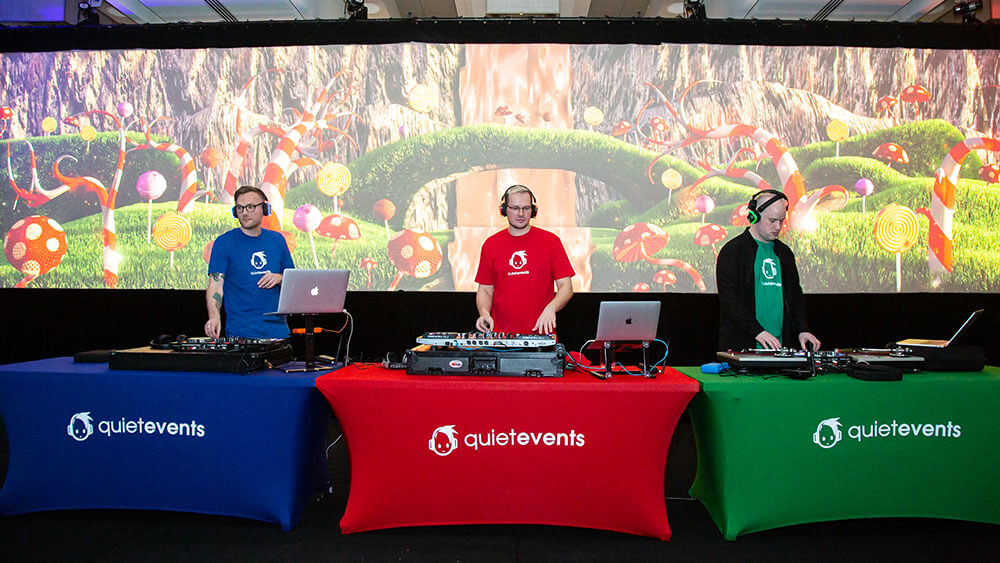
DJs from Quiet Events spin during the silent disco. After a slow start, by the end of the night “people were dancing.”
‘We Could Actually Talk to Each Other’
During the design phase, one of the things Endean always considers is how people might experience the same elements of a meeting differently, she said. “Contrary to popular belief,” said Endean, who speaks frequently on event industry topics, “I am more of an introvert than an extrovert.” She and her team mapped out how attendees might go through the meeting as an introvert or extrovert, including thinking about networking at evening events, connecting as first timers, and learning formats used in education sessions.
For the meeting’s welcome reception, held the first evening in a hotel ballroom, Endean’s concept — which fell squarely in the “let’s test this out” category — was a silent disco. There was a dance floor, and three DJs, competing against one another, playing music that participants listened to through headphones.
“It was one of those things where I thought, ‘Is this going to work? Hard to say,’” Endean said. And at the beginning of the event, “people would put on the headphones and dance for a minute and then take them off,” Endean said. But they liked having choices, she added. “One of our executives, he’s very much an introvert. And he put on the headphones and he said, ‘I’m just going to pretend to be dancing and be happy in my headphones.’” By the end of the night, “people were dancing hard,” she reported. “And the next day, I probably had 10 people thank me for giving them a welcome reception where they could actually talk to each other.”
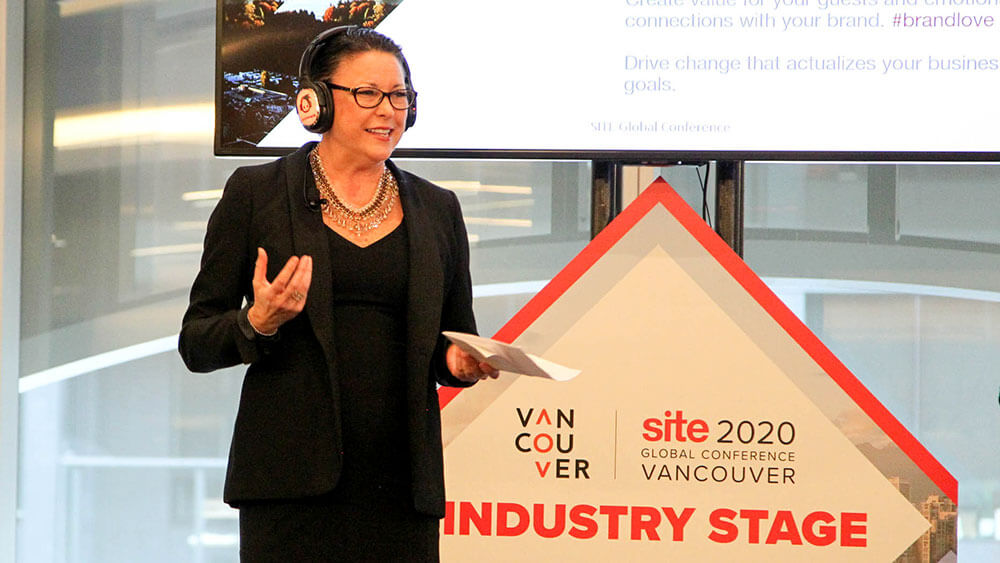
Judy Froehlich of BCD Meetings & Events speaks on SITE Global’s Industry stage. Some speakers teamed up for this presentations.
Challenging the Presenters
SITE put out a call for session proposals in advance of the meeting, and as Endean and her team designed the learning agenda, “We really challenged our presenters,” she said. “We got some presentations in and we thought, ‘These three presentations are really similar. But they come from different parts of the world and they all have great viewpoints. Instead of three different sessions, why don’t we put them together?’” It served SITE’s global audience well, Endean said, resulting in “some really successful sessions that were very different, because they were done by three people with a similar mindset, from three different parts of the world, and working from three different cultural contexts.”
Her team also looked for ways to engage participants with speakers’ messages beyond the stage, including keynote speaker Ben Nemtin, the author of The Buried Life. One of the things that Nemtin talks about is setting goals and working toward them, and “making the impossible possible,” Endean said. “So, as people walked out of the room, there was ‘Dream Wall’ where participants could record their own dreams. And then we made somebody’s dream come true the next day.” The chosen “dreamer” was a participant who wanted to strum a violin, Endean said. As it happened, a band with a violinist was playing at a session the next day, and the attendee “got to come up and strum a violin,” Endean said. “It was, for us, the smallest thing. For him, he’s still talking about it — he called his mom, he called his girlfriend.”
Looking back, what Endean thinks they did really well was to create a good mix of personal and professional content. “There was education that really was for the human beings in the room to leave with things that they could take away on a personal level,” she said. “And then there was another layer of sessions that was about the tactical, logistical, practical things we do every day.”
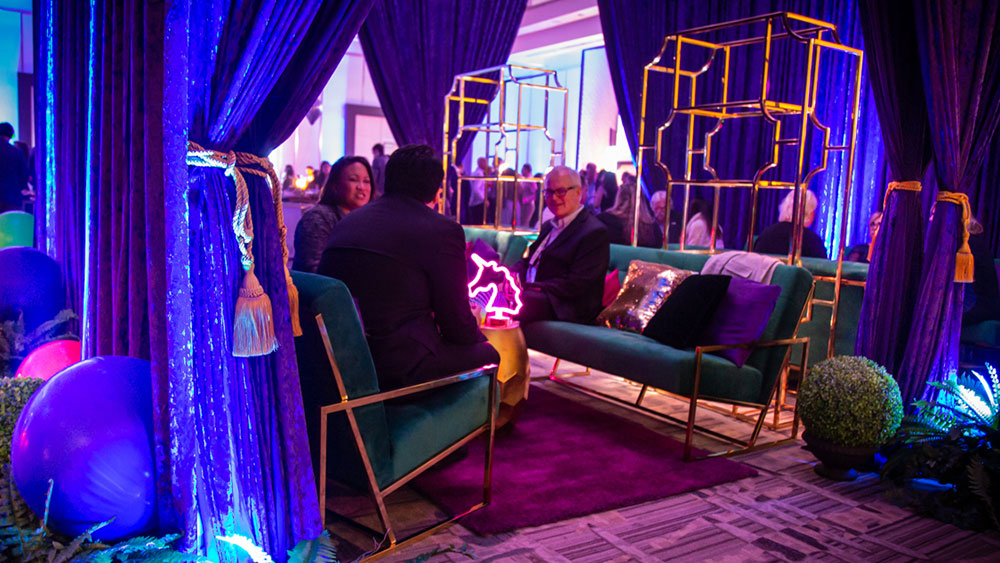
Attendees at SITE Global’s welcome reception chat in a semi-private space. Several thanked designer Tahira Endean for creating spaces where they could have conversations.
Do We Really Need to Talk About That?
Included in the personal category was a session called “SITE Storytellers,” where two “very brave” members talked about real-life journeys navigating professional lives that involved “some anxiety and mental health issues and burnout,” Endean said. Seeing someone standing on a stage, “talking about your wife having five miscarriages is not normally a thing that we would see at an event,” Endean acknowledged. “But everybody sitting in that room at some point has felt anxious or burned out, has lost someone, or gone through a personal health challenge.” The speakers’ message was that “they had a lot of support from their workplaces and from their friends, and what they called their ‘SITE family,’” Endean added. “They talked about being there for each other. And there was, for sure, people crying. But there’s nothing like a good tear at an event, if it’s authentic.”
RELATED: ‘Deepdive’ Immersions Help Attendees Experience Host City
Not every participant was comfortable with the session, Endean said. Some attendees’ reaction was: “Well, I don’t know if we needed to talk about that.” But, “I would disagree wholeheartedly,” Endean said, “and say we do need to talk about that, because real life happens every day to us. And they chose to tell their stories, and we didn’t drag anybody kicking and screaming onto that stage. They found that they were in a safe place to tell their story. And that is pretty incredible.
“Those are the moments,” Endean added, “where you’re just like, okay, that’s why we do this. We do events like this because we have the opportunity to touch people. And I think that you can’t be scared of that.”
Not everything worked seamlessly. New this year were “Dialogue Dens,” spaces set aside for conversation between the speakers and participants, without the help of AV. “The idea wasn’t that there would be a presentation and then you would talk about it,” Endean said. “The idea was that speakers would facilitate a conversation.” Since it was a new format, Endean and her team anticipated that participation would be very light — maybe 15 people, she said. But some speakers drew as many 50 attendees. “It was noisy,” Endean said. Next time, “we’ll keep the same non-audiovisual format, but we’ll give them bigger, quieter spaces.”
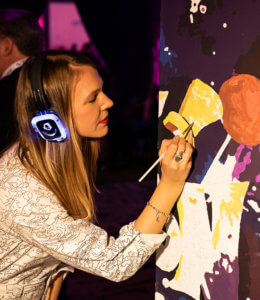
A participants shows some painting skills during the welcome reception. The SITE design team provided multiple activities to help attendees connect.
With Wellness in Mind
A key part of Endean’s approach to intentional design is focusing on wellness — “meetings and events are both deeply anticipated and notoriously hard on humans,” Endean writes in Intentional Event Design. “One of the comments that came back was it was so nice to always have coffee and water available” all the time, she said. “And that’s important, because we need to keep people hydrated.” The conference agenda offered runs, a SoulCycle session, yoga, and “a good balance of nutritious food,” Endean said. “It’s never going to be perfect. But it was good. And everything wasn’t a bagel and a cookie.”
One of SITE’s partners, a physicians’ group that offers on-site medical care, set up a lounge, with big comfortable chairs, warm blankets, and noise canceling headphones for an audio program that walked attendees through a guided meditation. Nutrition, hydration, pacing, along with combining personal and professional experience — it all adds up, she said. “When you feel recharged personally because you’ve had an aha moment at an event, I think that can take you pretty far.
“I think what sometimes people forget [is] that event design is designing,” Endean said. “We’re not just slapping a bunch of stuff together and hoping for the best. There [are] thousands and thousands of really great meeting planners out there who are doing an incredible amount of work to create spaces that people can learn in and be comfortable in. And I feel like that’s what we did. … And the results do show. I mean, the amount of effort that we put into the flow of the event, the content of the event, the working with the partners, just to have the simple things like water, or quiet, or ease of access to things, was noticed.”
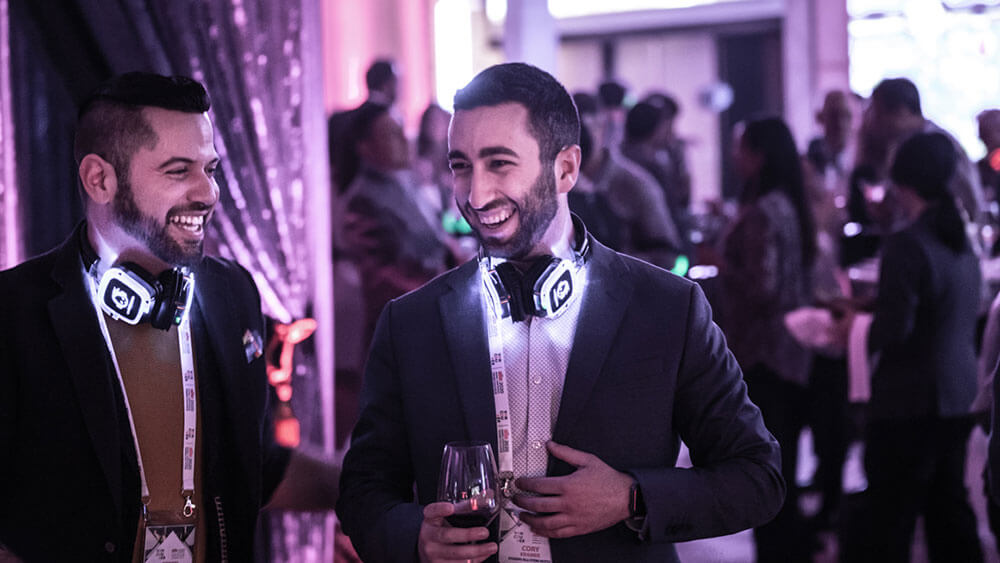
The value of shared time is the cornerstone we build events on, writes Tahira Endean, in Intentional Event Design.
Designing Transformative Meetings
An excerpt from Tahira Endean’s book, Intentional Event Design: Our Professional Opportunity, encourages event organizers to think more deeply about their roles:
“If you are paying attention to the massive global shifts affecting us as organizations and individuals, not only do we need to meet, we need to attend meetings that provoke thought, define forward-thinking, actionable learning, and provide a toolkit for participants to move ahead in ways which will positively affect business outcomes.
“This requires a combination of experience, intuition, and research into layers of human behavioral science and the effects of our responses to technology in a rapidly evolving world; a desire to create better cross-cultural and multigenerational experiences; the fortitude to move forward even when you face stakeholder fear; and knowledge you can apply to any event to deepen relevance. It is critical we continue to grow our understanding of the innate human responses to the elements included in live event environments to maximize our results.”
- Learn more about Tahira Endean’s event design philosophy.
Barbara Palmer is Convene’s deputy editor.
